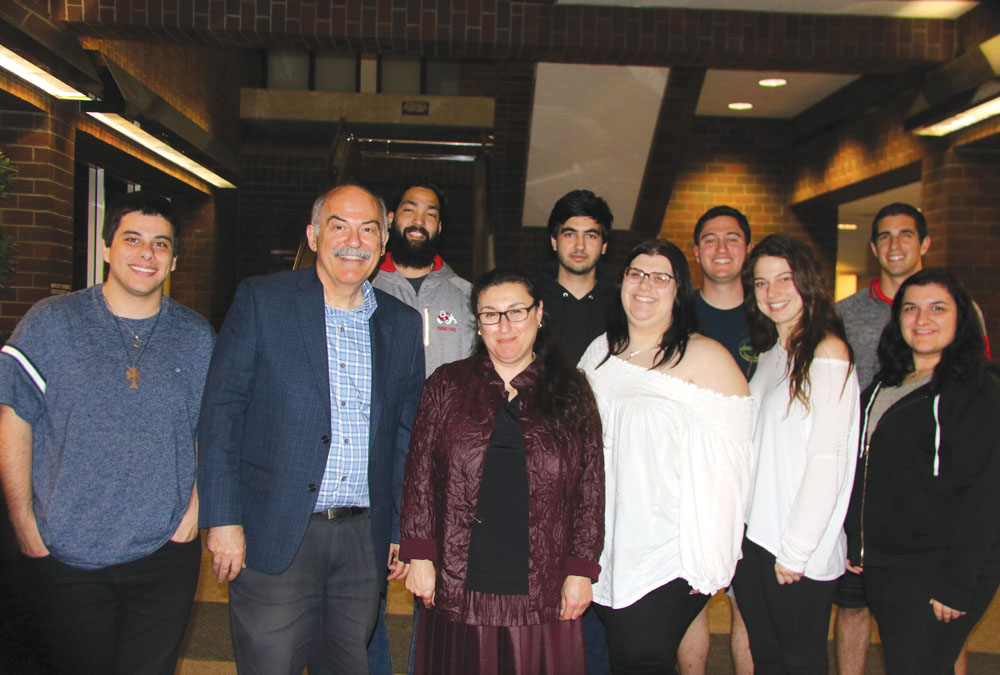Staff Report

Photo: Andrew Hagopian
A story of spiritual power, a work of unmatched artistic expression, intertwined with the Armenian Genocide, combined in an intriguing story related by Dr. Heghnar Zeitlian Watenpaugh. The journey of the “Zeytun Gospel,” from its creation by the great Armenian artist and miniature painter Toros Roslin, in the 13th century, to its place of honor in the town of Zeytun for centuries, and then its final harrowing tale of survival were recounted in a lecture “The Missing Pages: The Modern Life of a Medieval Gospel, from Genocide to Justice,” given by Dr. Watenpaugh on Thursday, April 4, at Fresno State.
Missing Pages is also the title of a new book authored in 2018 by Dr. Watenpaugh, an art historian at the University of California Davis. The “Missing Pages” are eight folios of the original 13th century “Zeytun Gospel” that are now in the Getty Museum collection in Los Angeles. The mother manuscript of the “Zeytun Gospel” is found in the collection of the Matenadaran in Yerevan.
How the eight folios became a part of the Getty collection is the question that puzzled Dr. Watenpaugh, who began to explore the history and the travels of the “Zeytun Gospel. “Her journey took her from the monastery of Hromkla where the manuscript was created, to high in the mountains of Zeytun where the manuscript was kept for hundreds of years as a powerful spiritual talisman, to its ultimate resting place in the Matenadaran and the Getty Museum.
Dr. Watenpaugh was drawn to the story when she heard about a lawsuit in 2010 between the Armenian Church, which claimed ownership of the manuscript, and the Getty Museum. The Armenian Church wanted the “Missing Pages” to be returned to the Church. Dr. Watenpaugh wrote an Op-Ed piece expressing her view that a solution could be found that would satisfy both sides.
In her investigation into how the folios had been removed, Dr. Watenpaugh became inspired to write the story of the “Zeytun Gospel.”
“During and after the Genocide,” said Dr. Watenpaugh, “the Zeytun Gospels intersected with the lives of individuals who venerated it, coveted it, treasured it, saved it, lost it, feared it, entrusted it to others, remembered it, and wrote about it.”
The Manuscript was created in the year 1256 by Toros Roslin, considered by most art historians as the greatest Armenian painter. The Gospel then found its way to Zeytun, where it was kept for centuries until the Armenian Genocide of 1915. It was kept as a “revered relic and liturgical object” in the Armenian Church of Zeytun and was only displayed on special occasions.
When the Genocide began, the Armenians of Zeytun were also subject to the deportations, but Asadur, of the noble house of Sureniants, one of the leading families in Zeytun, was allowed by the government to move to Marash for the duration of the war, instead of being sent on the marches. Asadur took the “Zeytun Gospel” to Marash, where the Gospel was entrusted to Dr. Artin Der Ghazarian, a surgeon and amateur historian, who convinced the family that it would be best to give the manuscript to him for safety.
Although the Ottoman Turks lost World War I, at the end of 1918, the Nationalist Turks of Mustafa Kemal attacked Cilicia in 1919-1920. In the chaos of the Armenian retreat from Marash, following the French abandonment of Cilicia, the manuscript was lost in the midst of a snow-storm. Later it was miraculously recovered and came into the hand of the Atamian family, who later settled in the East Coast. The secret of “The Missing Pages” is revealed in the new book.
Dr. Watenpaugh’s gripping retelling of “The Missing Pages” kept all in the audience at the edge of their seats.
The Missing Pages (Stanford University Press, 2019) is available through Amazon or your favorite bookstore.
 Hye Sharzhoom Armenian Action
Hye Sharzhoom Armenian Action